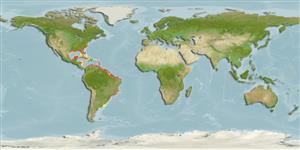>
Carangiformes (Jacks) >
Carangidae (Jacks and pompanos) > Caranginae
Etymology: Hemicaranx: Greek, hemi = the half + French, carangue, the name of a Caribbean fish; 1836 (Ref. 45335).
More on author: Cuvier.
Environment: milieu / climate zone / depth range / distribution range
Ecologie
marien; diepte ? - 50 m (Ref. 9626). Subtropical; 37°N - 41°S, 98°W - 34°W
Western Atlantic: North Carolina, USA and northern Gulf of Mexico southward to Florianópolis, Brazil; not found in most parts of the Lesser Antilles (Ref. 9626). Also found in Uruguay (Ref. 54736) and Argentina (Ref. 2806).
Grootte / Gewicht / Leeftijd
Maturity: Lm ? range ? - ? cm
Max length : 50.0 cm TL mannelijk / geslacht onbekend; (Ref. 26340); common length : 25.0 cm TL mannelijk / geslacht onbekend; (Ref. 5217)
Dorsale stekels (totaal) : 8; Dorsale zachte stralen (totaal) : 27; Anale stekels: 3; Anale zachte stralen: 23.
Adults are coastal species. They do not form large schools (Ref. 35237). Juveniles are encountered in brackish estuaries (Ref. 5217), moving to greater depths as it grows, but not deeper than 50 m (Ref. 9626). Eggs are pelagic, spawning occurs generally in summer (Ref. 35237). Marketed fresh (Ref. 9626).
Levenscyclus en paargedrag
Maturiteit | Voortplanting | Paaien | Eieren | Fecunditeit | Larven
Robins, C.R. and G.C. Ray, 1986. A field guide to Atlantic coast fishes of North America. Houghton Mifflin Company, Boston, U.S.A. 354 p. (Ref. 7251)
Status op de Rode Lijst van het IUCN (Ref. 130435: Version 2024-1)
Gevaar voor de mens
Harmless
Gebruik door de mens
Visserij: van minder commercieel belang
Tools
Speciale rapporten
Download XML
Internetbronnen
Estimates based on models
Preferred temperature (Ref.
123201): 22.9 - 28, mean 25.6 °C (based on 474 cells).
Fylogenetische diversiteitsindex (Ref.
82804): PD
50 = 0.5625 [Uniqueness, from 0.5 = low to 2.0 = high].
Bayesian length-weight: a=0.01122 (0.00514 - 0.02450), b=3.04 (2.87 - 3.21), in cm total length, based on all LWR estimates for this body shape (Ref.
93245).
Trofisch niveau (Ref.
69278): 3.9 ±0.3 se; based on diet studies.
Weerstandsvermogen (Ref.
120179): Gemiddeld, minimale populatieverdubbelingstijd 1,4-4,4 jaar (Preliminary K or Fecundity.).
Fishing Vulnerability (Ref.
59153): Moderate vulnerability (40 of 100).
Nutrients (Ref.
124155): Calcium = 95.3 [52.2, 207.3] mg/100g; Iron = 1.65 [0.91, 3.08] mg/100g; Protein = 20.1 [18.9, 21.3] %; Omega3 = 0.401 [0.248, 0.679] g/100g; Selenium = 19 [10, 37] μg/100g; VitaminA = 10.8 [3.5, 32.7] μg/100g; Zinc = 0.719 [0.503, 1.061] mg/100g (wet weight);
